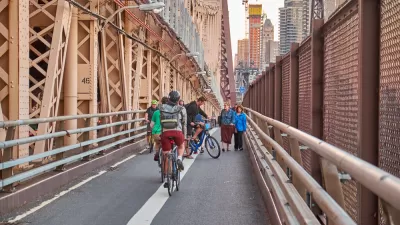The 200-acre operational rail yard is the largest of six affordable housing sites that Mayor Bill de Blasio targeted for development. He hopes to build more than 11,000 units of affordable housing there, but Gov. Andrew M. Cuomo is not on board.
In addition to the complexities of building over an operating rail yard similar to what is being done in the massive Manhattan Hudson Yards development, there are two owners of the yards—one friendly to development and the other apparently hostile to it.
Consequently, "the study will, at least initially, exclude portions of the site owned by the Metropolitan Transportation Authority (MTA) — an agency controlled by Gov. Andrew M. Cuomo, whose office has chafed at the idea," writes Matt Flegenheimer of The New York Times.
Amtrak, which owns much of the depot, has expressed an openness to the plan, and on Friday (Feb. 20) it praised what it called the mayor’s “leadership in advancing this effort.”
MTA and the governor maintain their opposition to building over the rail yards, which turns out not entirely unexpected as Mayor de Blasio and Gov. Cuomo have engaged in "a series of high-profile rifts," notes Flegenheimer
Wiley Norvell, a spokesman for the mayor, said city officials “hope and anticipate everyone being able to come together and collaborate here.” Mr. Norvell said any eventual plan would preserve existing rail service and account for future transportation needs at the site.
The Request for Proposal by the New York City Economic Development Corporation (NYCEDC) for consultancy services is to draft a feasibility study "to provide guidance as to the viability of an overbuild project at Sunnyside Yards."
FULL STORY: Despite Cuomo’s Opposition, de Blasio Requests Housing Proposals for Queens Rail Depot

Alabama: Trump Terminates Settlements for Black Communities Harmed By Raw Sewage
Trump deemed the landmark civil rights agreement “illegal DEI and environmental justice policy.”

Planetizen Federal Action Tracker
A weekly monitor of how Trump’s orders and actions are impacting planners and planning in America.

The 120 Year Old Tiny Home Villages That Sheltered San Francisco’s Earthquake Refugees
More than a century ago, San Francisco mobilized to house thousands of residents displaced by the 1906 earthquake. Could their strategy offer a model for the present?

In Both Crashes and Crime, Public Transportation is Far Safer than Driving
Contrary to popular assumptions, public transportation has far lower crash and crime rates than automobile travel. For safer communities, improve and encourage transit travel.

Report: Zoning Reforms Should Complement Nashville’s Ambitious Transit Plan
Without reform, restrictive zoning codes will limit the impact of the city’s planned transit expansion and could exclude some of the residents who depend on transit the most.

Judge Orders Release of Frozen IRA, IIJA Funding
The decision is a victory for environmental groups who charged that freezing funds for critical infrastructure and disaster response programs caused “real and irreparable harm” to communities.
Urban Design for Planners 1: Software Tools
This six-course series explores essential urban design concepts using open source software and equips planners with the tools they need to participate fully in the urban design process.
Planning for Universal Design
Learn the tools for implementing Universal Design in planning regulations.
Clanton & Associates, Inc.
Jessamine County Fiscal Court
Institute for Housing and Urban Development Studies (IHS)
City of Grandview
Harvard GSD Executive Education
Toledo-Lucas County Plan Commissions
Salt Lake City
NYU Wagner Graduate School of Public Service



























